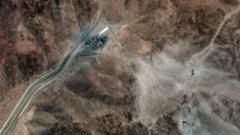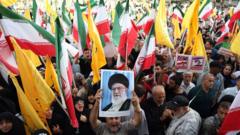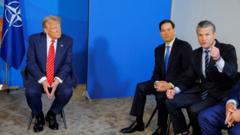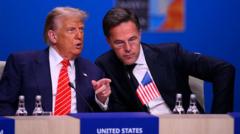After the cessation of hostilities between Israel and Iran, discussions surrounding Iran's nuclear program have reignited, with conflicting reports emerging about the impact of recent U.S. military strikes.
**Tensions Ease as Cease-Fire Holds: Analyzing Claims on Iran’s Nuclear Program Post-Conflict**

**Tensions Ease as Cease-Fire Holds: Analyzing Claims on Iran’s Nuclear Program Post-Conflict**
As the Israel-Iran cease-fire garners attention, Trump disputes intelligence assessments on Iran’s nuclear capabilities.
As of June 25, 2025, the cease-fire between Israel and Iran appears to be stable, allowing both nations to begin the process of returning to normalcy. The conflict, which was marked by intense military actions including Israeli airstrikes on Iranian nuclear facilities, has raised critical questions about the future of Iran's nuclear ambitions. Amidst this backdrop, President Trump has openly contested a preliminary U.S. intelligence report from the Defense Intelligence Agency that suggests the strikes only delayed Iran’s nuclear program by a matter of months.
At a NATO summit held in the Netherlands, Trump dismissed the intelligence findings as inconclusive, reiterating his belief that U.S. military intervention resulted in the “obliteration” of Iran’s nuclear capabilities. He suggested that Iranian leaders did not have the opportunity to relocate enriched uranium prior to the strikes, a claim that contradicts observations from the UN’s nuclear watchdog. The cease-fire, brokered by Trump, has led both Israel and Iran to declare victories, while international leaders and observers remain skeptical about the durability of the truce.
In the aftermath of the conflict, Israeli authorities have lifted emergency measures that had restricted activities within their borders, indicating a shift back to routine operations. This includes the reopening of Ben Gurion Airport, facilitating international travel. In Iran, supporters rallied to celebrate their resilience, with President Masoud Pezeshkian expressing readiness for renewed diplomatic negotiations focused on the nuclear program.
While the initial cease-fire was marred by accusations of continued military provocations, both sides have largely observed the truce, suggesting a focus on stability moving forward. Trump has indicated optimism that continued peace discussions, particularly regarding Gaza, may now gain traction.
Conversely, Congressional criticism mounts towards the Trump administration for delaying classified briefings that should have provided further context on military actions against Iran. Lawmakers demand clarity on the extent of damage inflicted on Iran’s nuclear infrastructure versus claims of a significant setback.
Military assessments indicate that while some damage was indeed inflicted on key Iranian sites, the preliminary report suggests that these facilities experienced moderate effects rather than total destruction. The uncertainties surrounding damage to Iran's ability to resume nuclear development sustain concerns about future aggression and military actions.
In light of these complex layers surrounding the cease-fire and military actions, it is evident that the situation remains fluid, balancing on the precipice of ongoing geopolitical narratives and international relations. The path toward a durable and peaceful resolution may hinge not just on military strategies but on diplomatic engagements and mutual recognition of boundaries, particularly regarding nuclear developments in the volatile Middle East.























